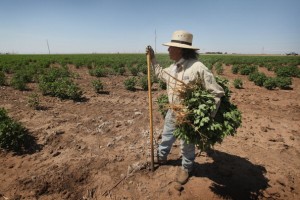Texas Lost Over 1 Million Acres Of Private Farm and Ranch Land In 15 Years

Photo by Scott Olson/Getty Images
Juan Rico culls cotton plants growing between rows in an irrigated cotton field July 27, 2011 near Hermleigh, Texas.
Talk of Texas often conjures images of wide open ranch land and farmers at work their fields. But that iconic territory is being lost, according to a new analysis.
Dr. Roel Lopez, director for Texas A&M Institute of Renewable Natural Resources, says the state lost over 1 million acres of privately-owned farm land and forest land between 1997-2012. He presented the information this week at a conference of the Texas Agricultural Land Trust, a nonprofit conservation group.
The conference, called “No Land No Water,” focused on what Lopez believes are inefficient and unsustainable landowning trends in Texas’ flourishing economy.
“In the past 15 years, we’ve seen a little over a million acres of working lands converted to other uses,” he says.
Land conversion can mean more than a loss of grazing space and pretty views. Lopez worries it will further impede water recharge by replacing soft, absorptive ground cover with impenetrable material, like road cement.
So how can rural property owners protect land and water from development? The remainder of speakers at the conference suggested conservation easements as a viable answer. The Texas Agricultural Land Trust is one of several groups that works with landowners in securing and enforcing easements
“A conservation easement is an agreement between a landholder and a qualified trustee,” Allison Elder, a representative of the trust, says. “It’s designed to permanently protect the special natural resources of the property.”Basically, landowners donate their property to groups that will promote conservation upon the donated land. To accomplish this, trusties focus on removing certain rights from land titles they’re given.
“Typically it’s going to be the right to subdivide,” says Elder, “the right to do a lot of intense commercial or industrial uses.”
Naturally, these restrictions reduce the monetary value of the protected land. To offset that landowners may receive tax benefits if their easement meets certain requirements.
To exemplify the potential success of conservation easements, Dr. Francine Romero, chairman of San Antonio’s Conservation Advisory Board, described an easement-driven policy San Antonio has used to protect over 126,000 acres, or about 25%, of the Edwards Aquifer recharge zone in Bexar, Medina and Uvlade counties.
“The Edwards Aquifer Protection Program purchases land, by conservation easements, on our recharge zone,” she says. In 2000, San Antonio voters approved the program to use a fraction of the city’s 8.25% sales tax to protect their largest source of drinking water.
Although that program has been successful in securing land, it may not be enough to keep up with the city’s booming population and continued drought. Romero is concerned council members and voters won’t reelect the program for sales tax funding in 2015.
The city is also considering investing in a multi-billion dollar water pipeline project from Burleson County to bring water in from the Carrizo-Wilcox aquifer.